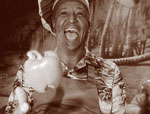 The cooking of the Caribbean is a reflection of the colourful and sometimes tragic history of this remarkable cluster of islands. Every Caribbean cooking style starts with the local ingredients: tropical fruit, chicken, fish and fresh vegetables. To these add spices, yams, peppers and coconut, and the flavour of the Caribbean begins to take shape.
The cooking of the Caribbean is a reflection of the colourful and sometimes tragic history of this remarkable cluster of islands. Every Caribbean cooking style starts with the local ingredients: tropical fruit, chicken, fish and fresh vegetables. To these add spices, yams, peppers and coconut, and the flavour of the Caribbean begins to take shape.
The first inhabitants were the Arawaks and the Caibs, descendants of native South Americans who crossed the water from Venezuela and Guyana and settled in the Caribbean long before Christopher Columbus or any other European has sighted the islands. For the Arawaks and Caribs, their new home must have seemed a miracle of abundance and, surrounded by fish, fruit, yams and other vegetables all there for the taking, they thrived.
But in the sixteenth century they found themselves caught in the crossfire of competing colonial interests. The British, French, Portuguese, Spanish and Dutch all sought to seize as many of the Caribbean islands as they could. The islands were a staging post on the great sea journey to the fabulous riches of South America, and every island was a potential base, fortress and treasure hoard.
Although the original inhabitants had grown crops such as corn and beans, they survived largely on the natural plenty all around them. But among the new European colonists were those with a different idea: farming on a giant scale. They brought new animals and plants to the Caribbean: pigs, cattle and sheep appeared on the islands for the first time, as did bananas, coconut, limes, mangoes, coffee and rice. For the colonists, the Caribbean promised the same instant wealth as the spice islands of the Indies. Europeans, who came as soldiers and sailors to conquer, stayed to build plantations devoted to sugar cane, bananas and other exotic crops. The plantations needed labour, and the great Caribbean tragedy began. Black slaves in their millions were shipped in from West Africa, condemned to a short life of misery, poverty and grinding hard work.
When the slave trade ended in the nineteenth century, indentured labourers came from India and China to work on the plantations, together with their traders and merchants eager to share the wealth. The great melting pot of Caribbean culture was now complete: the Spanish, French, Africans, Scots, Irish, English, Dutch, Indians and Chinese all brought their music, their sport, their language and their cooking styles, to merge and re-emerge in a riot of colour, sunshine and joie de vivre.
Every Caribbean cooking style starts with the local ingredients: tropical fruit, chicken, fish and fresh vegetables. To these add spices, yams, peppers and coconut, and the flavour of the Caribbean begins to take shape.
At least one style of Caribbean cooking can now be found all over the world - the barbecue. The word can be traced to French pirates in the Caribbean who gave a particular name to a whole pig roasted on an open fire - de barbe ÃÂÂ queue, meaning literally "from beard to tail".
The traditional dishes of the Caribbean come from a variety of sources. Jerk Chicken began with the fire-breathing spices necessary to make dried beef or dried venison - jerky to the early European sailors - more edible on long sea voyages. The same sailors brought salt cod with them - salting was another way of preserving food. Today, salt cod is treated as a delicacy. Stamp and Go, as spicy fishcakes are called, was sold from seaside stalls and came wrapped in paper stamped with the word "paid" - you paid and off you went.
The extensive use of spices makes Caribbean food lively and different and, like so many cooking traditions, owes its beginning to pure necessity. African slaves frew tired of the boring and basic food they were given, and made it palatable with a hefty sprinkling of locally grown spices. But, most of all, Caribbean food is about fresh ingredients, freshly cooked. It is our great good fortune today that even the most exotic ingredients can be found in supermarkets all around the world. We no longer have to travel to Trinidad or Jamaica to share the joy of fresh mango or pineapple, or to Havana to mix a rum cocktail. The flavours of the Caribbean have been brought to us, wherever we live. In the recipes of this section, we have tried to use only those ingredients that are easily obtainable. If an ingredient is hard to find, we've tried to offer you a substitute.
So imagine yourself on a sunny beach, with the sparkling Caribbean lapping gently on the sand, a steel band playing softly in the distance and the glorious tastes of the tropics surrounding you. If you can't make a real-life journey to the Caribbean, you can still sample the flavours and delights at home, using these recipes.
www.foodnouveau.com

